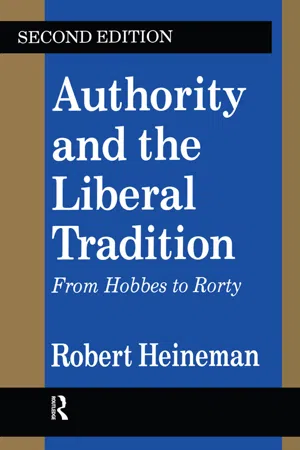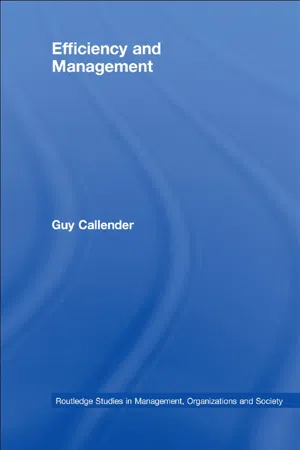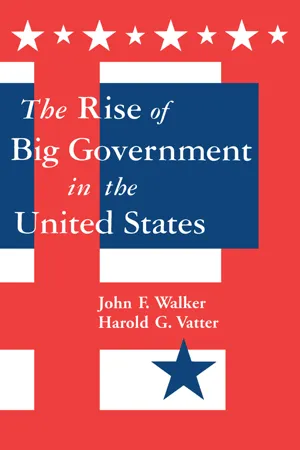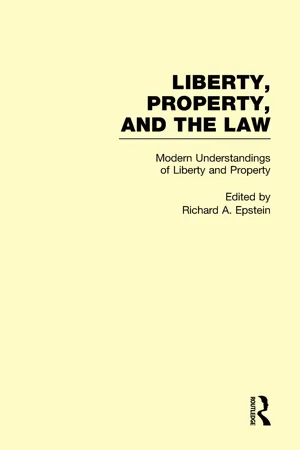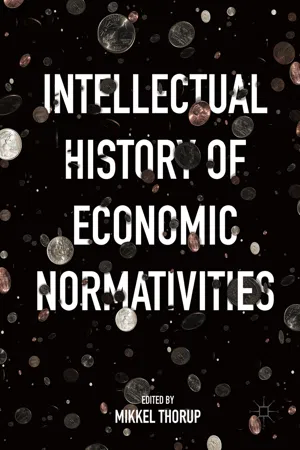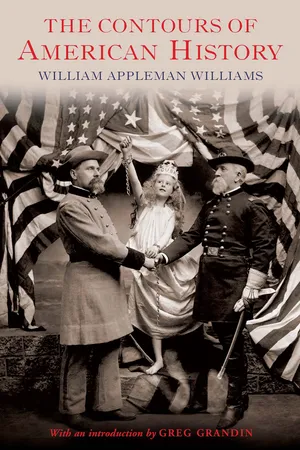History
Laissez-Faire in American History
Laissez-faire in American history refers to a hands-off approach to government intervention in the economy. It became prominent during the 19th century, particularly in the Gilded Age, and was associated with minimal regulation and free market capitalism. Proponents believed that the economy would thrive best without government interference, while critics argued that it led to exploitation and inequality.
Written by Perlego with AI-assistance
Related key terms
7 Key excerpts on "Laissez-Faire in American History"
- eBook - ePub
Authority and the Liberal Tradition
From Hobbes to Rorty
- Robert Heineman(Author)
- 2020(Publication Date)
- Routledge(Publisher)
Laissez Faire Becomes Public PolicyThe proponents of limited government and economic individualism had widespread public support during much of the latter nineteenth and early twentieth centuries in the United States; and their views soon became part of the supreme law of the land as enunciated by the nation’s highest court. The laissez faire position gained additional credence from the tremendous economic and technological advances that occurred during this period. As a result, many Americans became convinced that governmental power was not necessary for domestic prosperity; and, thus, they saw no need to formulate an articulate theoretical basis for government as a democratically responsive force for social direction.William Graham Sumner and Minimal Government
The foremost academic spokesman for laissez faire ideas in latter nineteenth-century America was, without a doubt, William Graham Sumner. An instructor at Yale University from 1868 until the early twentieth century, Sumner spent the better part of the period from 1870 through the early 1890s popularizing the doctrine of limited government and individual freedom. He was more than a devotee of the ideas of Spencer, however. His thought represents a fairly comprehensive amalgam of the currents comprising the intellectual revolution of the time. Adherence to the ideas of individualism and laissez faire originated from his early acquaintance with the thought of the classical economists.1 Much of his methodology seems to have been derived from his educational years spent abroad in Germany. His acceptance of Spencer’s ideas and their Darwinian parallels originally stemmed not from the Social Statics but from the later The Study of Sociology.2 Richard Hofstadter’s statement that Sumner “brought together three great traditions of western capitalist culture: the Protestant ethic, the doctrines of classical economics, and Darwinian natural selection…”3 - eBook - ePub
- Guy Callender(Author)
- 2008(Publication Date)
- Routledge(Publisher)
At the time that democracy became more egalitarian and diverse in its objectives, laissez-faire became the populist economic doctrine that dominated UK economic policy. Arguably, one consequence was the comparative decline in national certainty of purpose and macro-efficiency. In place of national goals and international dominance, the individual rights of owners to pursue their own paths to their ‘profits on investment’ 97 became a dominating economic force. This chapter has evaluated a diversity of qualitative economic issues that have emerged in Anglo-American economies over the past two centuries. The aim of this historical review has been to underline the comparative speed with which some Anglo-American economies have shifted, at times rapidly, from laissez-faire to centralized models of economic policy on a pragmatic basis. The chapter also raises the question: is the basis of economic theory, and therefore the foundations of its dominant position in the social sciences, objectively scientific or socio-political? The answer to this question may never be entirely clear. Yet the varying influences that have been identified in the historical analysis of the changing economic epochs of the past 120 years, and the overtly loose linkage made by Friedman between the size of government and the size of the tithe (which is a culturally-embedded belief rather than a universal measure), pose fundamental questions about the supposed scientific basis of economics - eBook - ePub
- Harold G. Vatter, John F. Walker(Authors)
- 2015(Publication Date)
- Routledge(Publisher)
Government before 1929 had been growing absolutely and relatively to total economic activity, but remained small relative to that total. Such intervention as had been successfully demanded by interest groups was largely of a regulatory or supervisory character that left the basic performance of the economy to the vagaries of the market. A “social market economy,” to use German Ludwig Erhard’s term, did not exist. Neither did a welfare state. The United States was far behind other western democracies in these respects. Nor did “state capitalism” of the German and Italian fascist variety or the Japanese type exist. In the tradition of laissez-faire, the federal government was still largely the executive committee of the dominant corporate business interests, and the state and local governments kept the market system’s house in order. Nobody who was anybody was seriously concerned at that “moment of truth” on the edge of the Great Depression about the distribution of income and wealth, the level of employment, inflation or deflation, the business mortality rate, rate of economic growth, the rights of labor, the security of the elderly, protection against ill health, environmental damage, or the increasing global interconnections facing the American economy in the years ahead.Harold U. Faulkner’s brilliant economic history dates the decline of laissez-faire in the progressive years 1897–1917. He insightfully calls attention to the fact that much of the interventionist reform legislation in that period was designed to restore a Paradise Lost of free competition and laissez-faire.13 Until this utopianism was overcome laissez-faire could not be overcome. The paradox was resolved beginning in the Great Depression. It is for that reason that the Depression and the New Deal represented a discontinuity in economic history and in the relationships between government and the market system. The decline of laissez-faire was transformed into its demise with the rise of the early mixed economy. To that institutional transformation in the relationships between government and the market system we now turn.Notes
1. Referred to in Richard Hofstadter, The Age of Reform (New York: Random House, 1955), p. 231.2. John Kenneth Galbraith, American Capitalism: The Concept of Countervailing Power (Boston: Houghton Mifflin, Sentry ed., 1962).3. Cited in Janet A. Napoli, “Derivative Markets and Competitiveness,” Federal Reserve Bank of Chicago, Economic Perspectives - eBook - ePub
- David Schweickart(Author)
- 2018(Publication Date)
- Routledge(Publisher)
Modern liberalism, both the “standard” and “new” versions, will be analyzed in detail later, with Rawls and Thurow serving respectively as representatives. But the major portion of this work will involve a comparison of a form of socialism – what I shall call “Economic Democracy” – with classical liberalism’s laissez-faire ideal. Laissez faire is the purest form of capitalism, the one that most clearly exhibits capitalism’s underlying structure. It is also the form out of which, by way of reaction, the other ideals have emerged. It is essential to understand this model – its structure and dynamic, its strengths and weaknesses – in order to comprehend adequately the other forms of capitalism, or, for that matter, certain features of Economic Democracy. We shall return to alternative conceptions of capitalism later, but it is this basic form that we must now examine.Capitalism: Laissez FaireApart from a few libertarian anarchists, no classical-liberal theorist advocates complete laissez faire. All recognize that government must engage in certain economic activities, from defining property rights and enforcing contracts to checking monopolistic power. Nevertheless, laissez faire lies close to the heart of classical liberalism. However much its advocates may disagree on secondary matters, they are united on this basic point: As much as possible, the economy should run itself.But how can an economy run itself? How can millions of individuals produce, distribute, and consume millions upon millions of products unless guided by some central authority or some rigid tradition? The answer was formulated two centuries ago by Adam Smith:As every individual, therefore, endeavors as much as he can both to employ his capital in the support of domestic industry and so to direct that industry that its produce may be of the greatest value, every individual necessarily labours to render the grand revenue of the society as great as he can. He generally, indeed, neither intends to promote the public interest, nor knows how much he is promoting it.… He intends his own gain, and he is in this, as in many other cases, led by an invisible hand to promote an end which is no part of his intention.… By pursuing his own interest he frequently promotes that of society more effectually than when he really intends to promote it.17The essential elements of this rather remarkable process are by now well known. Individual greed is held in check by competition. The “invisible hand” directs via that mighty law: supply and demand. If society wants more boots than are being supplied, and fewer sandals, then bootmakers can raise their prices, and sandalmakers must lower theirs. With bootmaking now more profitable, people and resources shift from sandalmaking to the boot business. Thus the supply of boots increases, and that of sandals declines – in accordance with society’s desires, but without any central command. - eBook - ePub
Modern Understandings of Liberty and Property
Liberty, Property, and the Law
- Richard A. Epstein(Author)
- 2013(Publication Date)
- Routledge(Publisher)
I will carefully avoid using the term laissez faire to mean what only unscrupulous or ignorant opponents of it and never its exponents make it mean, namely, philosophical anarchism, or opposition to any governmental power or activity whatsoever. I will in general use the term to mean what the pioneer systematic exponents of it, the Physiocrats and Adam Smith, argued for, namely, the limitation of governmental activity to the enforcement of peace and of "justice" in the restricted sense of "commutative justice," to defense against foreign enemies, and to public works regarded as essential and as impossible or highly improbable of establishment by private enterprise or, for special reasons, unsuitable to be left to private operation. Both the Physiocrats and Adam Smith gave some sanction to the limited expansion of governmental activity beyond these limits. Following their example, I will not deny the laissez faire label to any writer who in general accepts the limitations I have enumerated to governmental activity, even if he occasionally, incidentally, and inconsistently relaxes these limitations slightly to permit either of a restricted list of minor exceptions or of temporary suspension of the laissez faire code in case of emergency or abnormal conditions, such as war, famine, or earthquake.No social doctrine has a meaningful historical life except with reference, explicit or implicit, to an existent or conceivable alternative or array of alternatives. It is a useful simplification as a first approximation to regard the alternatives to laissez faire as lying along a straight line measuring degrees of governmental intervention in the field of economic activity. Looking in one direction, this straight line represents Herbert Spencer's road to "The Coming Slavery," or Friedrich Hayek's "Road to Serfdom." It is only since the eighteenth century "Enlightenment" that slavery and serfdom have been regarded as pejorative terms. Those well-disposed towards laissez faire should therefore perhaps use in preference such terms as "Road to Tyranny" or "Road to Totalitarianism," labels which as far as I know no one would ever have chosen for highways on which he wished mankind to travel. Looking in the other direction, however, this highway also represents the Road to Anarchy. In any case, along this road are many conceivable stopping-places, and no one may be interested in either of its terminal points. Route 1, a great national highway which connects Boston, New York, Philadelphia, Baltimore, and Washington, begins at Fort Kent in Maine and ends at a sand-dune at the southern tip of Florida. Except on the arbitrary assumption that travel on this road, in either direction, is totally without benefit of brakes, the terminal points of our metaphorical road are often assigned an extravagant degree of practical significance in discourse in this field. Until quite recent years, actual and vital discussion in the public forum has turned mainly on the comparative merits as resting-places along our highway of points not greatly distant from each other, or perhaps more accurately, as between no movement at all and a limited amount of movement, sometimes in both directions simultaneously, from the existing resting-place. Before World War I the issue in debate was never, as far as I can see, between laissez faire and totalitarianism, or between the welfare state and philosophical anarchism. As I will be dealing mostly with pre-1914 facts or ideas, I will spend no time on St. George-and-the-dragon types of argument. - eBook - ePub
- Mikkel Thorup, Mikkel Thorup(Authors)
- 2016(Publication Date)
- Palgrave Macmillan(Publisher)
In this chapter, I will try to understand how and why the colonial administration chose a catastrophic policy of non-intervention, despite a formulated policy which stated that saving the lives of the natives was of ‘paramount importance.’ 2 Based on an examination of letters, reports, and correspondence from the colonial administrations in India and London and the public debate in Britain, a picture emerges where economic ideas of laissez-faire liberalism played a crucial role in the formulation as well as the legitimation of this policy. In his 1960 essay The Intellectual History of Laissez-faire, Chicago school economist Jacob Viner describes the nineteenth-century doctrine of laissez-faire as summed up by the central idea, taken from Adam Smith and the French Physiocrats, that economic transactions should be left to private actors in a free market and the activity of government should be limited to the enforcement of peace and justice. 3 In times of scarcity and famine, this implies non-intervention in the grain trade and only very limited distribution of food and relief, to avoid individuals becoming dependent on support from the state. 4 The relief efforts during the Great Famine of 1876–1878 provide a clear example of the strict application of these principles in practice, and represent perhaps the largest historical experiment with laissez-faire regulation in times of famine. Laissez-faire liberalism provided not only technical inputs to policy, but also a language of moral justification, where current suffering could be understood as the necessary cost of the burgeoning commercial society. The hard laissez-faire line did not represent the only position in the debates - eBook - ePub
- William Appleman Williams(Author)
- 2011(Publication Date)
- Verso(Publisher)
Since they denied the necessity, desirability, or morality of any sustained effort to coordinate and direct the affairs of society, the advocates of laissez faire were impaled on the horns of an obvious dilemma when the system failed to function satisfactorily. Their warrant authorized them to deal only with fundamental issues: that is, defining the market place, certifying the units of competition, and specifying the rules of the game. Though they were dedicated to liberty and freedom of action, and did indeed throw open many gates in the society, the proponents of laissez faire were at the same time narrowly confined by their philosophy. In that respect, at any rate, they were less free than the mercantilists, who could deal with a basic question like the need and usefulness of a national bank by concentrating on controlling its power, and who could approach slavery as an institutional problem of the political economy rather than as a personalized sin.As revealed in their assertion that the open conflict of self-interests would produce the general welfare, and in the persistent use of moral terms of judgment—by Jackson and the mechanics, as well as by Emerson and the abolitionists—the men of laissez faire were constantly thrown back on first principles. As a result, every spot of trouble became a sore point at issue. In one sense, of course, the resulting tension was a powerful engine of development. It provoked the advocates of laissez faire to change reality to conform with their a priori ideas and ideals, thus generating a tremendous momentum to manhandle nature and provide a better life. But such a drive to reshape reality could easily become a crusade to override men who disagreed with the axioms of laissez faire. And that could lead to violence.Fearing just such an eventuality, Henry Clay struggled between 1834 and 1851 to reestablish and institutionalize the key ideas and policies of his mercantilist American System. The effort was neither as irrelevant nor as feeble as his ultimate failure might indicate. For one thing, the serious depression which began shortly after Van Buren’s inauguration in 1837 raised basic questions about the ability of laissez faire to deliver on its promises concerning personal happiness and the general welfare. And the President’s repeated assertion of laissez-faire dogma did little to generate recovery or to satisfy the demands from various groups and sections for assistance or other special treatment.
Index pages curate the most relevant extracts from our library of academic textbooks. They’ve been created using an in-house natural language model (NLM), each adding context and meaning to key research topics.
